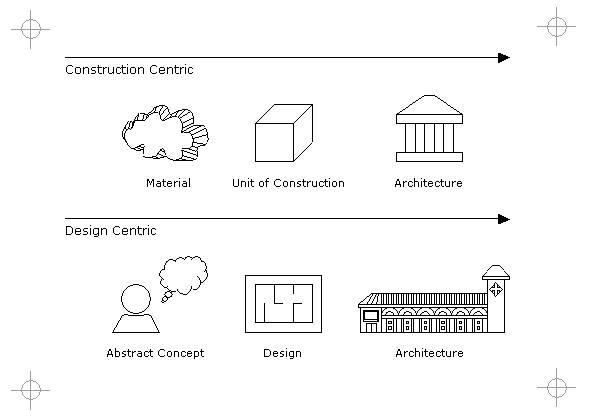|
Diagram
|
|
|

|
|
Title
|
|
|
Classical Architecture
|
|
Building Architecture
|
|
|
The term "classical" is used to define the cultural ideals from the Greek and Roman world - in particular - architecture, literature and music. It constitutes a Western view of civilisation and history. It is used in the story as a period of learning. The early period, methods are constrained by the materials and technology which are discovered and used. The materials shape the architecture - structure, function and aesthetics. In later stages of the classical period, construction methods, decoration and ornamentation play an increasing role. A design centered approach to construction is taken to deal with complexity and when our approach to construction matures or is better understood.
|
|
Architecture Intensive Disciplines
|
|
|
Classical can also define systems or methods that constitute and accepted approach. In many ways, we are still in the "classical" phase of software and systems architecture. We are establishing accepted approaches and are also constrained by the materials or technologies we discover. For instance, web services provide a set of "units of construction" which cause us to re-think our existing architectures. We are able to leverage abstract concepts and design as our construction processes mature. In turn, better design can improve construction.
|
|
Case Study A: Large Corporate IT
|
|
|

|
|
|
Web based development typically lacked programming structure. On the one hand the web development was construction centric. The work undertaken using an architecture and design centered approach had to be proven as the majority of developers simply did not apply analysis and design methods. Visual modeling was introduced and mentored. Initially, the majority of Microsoft developers on contract would cut and paste sample code from the internet. Personal skills development was initially limited to operating the tools rather than on the knowledge issues of theoretical understanding, design patterns and best practices.
|
|
Case Study B: Small Commercial Team
|
|
|

|
|
|
There was no technical documentation and a lack of standards. The software was built by adding function on top of function with little structural design or architectural consideration. After evaluating the system from bottom up, an architectural vision was established within the first month. It included separation of tiers, the identification of a middle tier library and support for 3 user interface platforms. This architectural vision drove the refactoring which resulted in a major re-structuring of the internal component architecture.
|
|
|